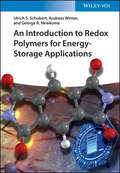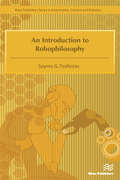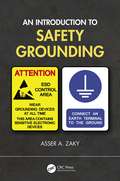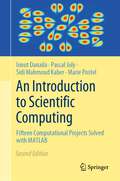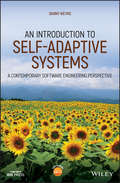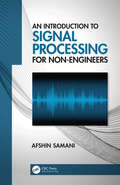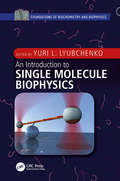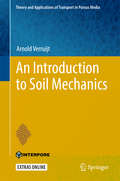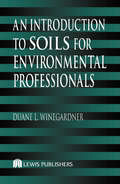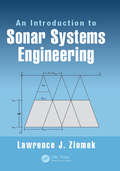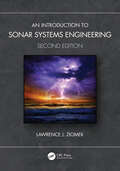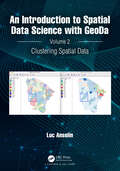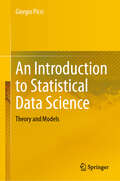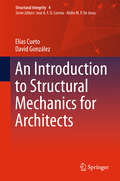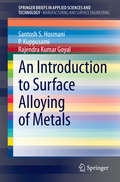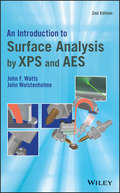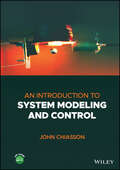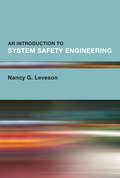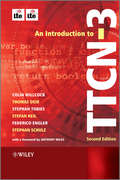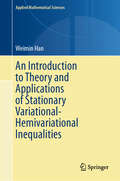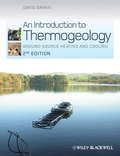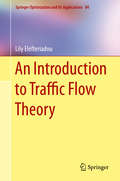- Table View
- List View
An Introduction to Redox Polymers for Energy-Storage Applications
by Andreas Winter Ulrich S. Schubert George R. NewkomeAn Introduction to Redox Polymers for Energy-Storage Applications Presents a well-founded introduction to the field or Redox Polymers, with didactical features like summary boxes and a Q&A sections An Introduction to Redox Polymers for Energy-Storage Applications discusses fundamental aspects related to polymer-based batteries, such as types of batteries, their historic development, design and synthesis criteria of the active material, and summarizes the various types of redox polymers and their applications. Each chapter contains learning objectives, summary boxes, and questions to allow for efficient exam preparation. In An Introduction to Redox Polymers for Energy-Storage Applications, readers will find detailed information on: Fundamental aspects of redox-active polymers, along with their historical classification, taking the key applications of the materials into account Energy-storage devices, containing polymers as the electrode active materials, and specific material requirements for the desired applications Classification of redox-active polymers, e.g., according to the nature of the actual redox-active moieties, their backbone structure, or topology Electrical conductivity of conjugated polymers, covering their most prominent representatives (polyaniline, polypyrrole, polythiophene, and polyacetylene) An Introduction to Redox Polymers for Energy-Storage Applications also covers the synthesis and applications of these materials, making it an excellent book for graduates, PhD students, and professionals who are starting in this field.
An Introduction to Reservoir Simulation Using MATLAB/GNU Octave: User Guide for the MATLAB Reservoir Simulation Toolbox (MRST)
by Knut-Andreas LieThis book provides a self-contained introduction to the simulation of flow and transport in porous media, written by a developer of numerical methods. The reader will learn how to implement reservoir simulation models and computational algorithms in a robust and efficient manner. The book contains a large number of numerical examples, all fully equipped with online code and data, allowing the reader to reproduce results, and use them as a starting point for their own work. All of the examples in the book are based on the MATLAB Reservoir Simulation Toolbox (MRST), an open-source toolbox popular popularity in both academic institutions and the petroleum industry. The book can also be seen as a user guide to the MRST software. It will prove invaluable for researchers, professionals and advanced students using reservoir simulation methods. This title is also available as Open Access on Cambridge Core.
An Introduction to Robophilosophy Cognition, Intelligence, Autonomy, Consciousness, Conscience, and Ethics: Cognition, Intelligence, Autonomy, Consciousness, Conscience And Ethics (River Publishers Series In Automation, Control, And Robotics Is A Series Of Comprehensive Academic And Professional Books Which Focus On The Theory And Applications Of Automation, Control And Robotics. The Series Focuses On Topics Ranging From The Theory And Use Of Control Systems, Automation Engineering, Robotics And Intelligent Machines. Books Published In The Series Include Research Monographs,)
by Spyros G. TzafestasModern robots have arrived at a very matured state both in their mechanical / control aspects and their mental aspects. An Introduction to Robophilosophy explores the philosophical questions that arise in the development, creation, and use of mental – anthropomorphic and zoomorphic- robots that are capable of semiautonomous / autonomous operation, decision making and human-like action, being able to socially interact with humans and exhibit behavior similar to human beings or animals. Coverage first presents fundamental concepts, and an overview of philosophy, philosophy of science, and philosophy of technology. The six principal mental capabilities of modern robots, namely cognition, intelligence, autonomy, consciousness, conscience, and ethics are then studied from a philosophical point of view. They actually represent the product of technological embodiment of cognitive features to robots. Overall, readers are provided a consolidated thorough investigation of the philosophical aspects of these mental capabilities when embedded to robots. This book will serve as an ideal educational source in engineering and robotics courses as well as an introductory reference for researchers in the field of robotics, and it includes a rich bibliography.
An Introduction to Safety Grounding
by Asser A. ZakySafety or protective grounding is of vital importance for the protection of individuals from electric shock and structures and industrial concerns from potentially damaging lightning and electrostatic discharges. To many electrical engineers the notion of grounding is nebulous and safety grounding is quite often confused with neutral grounding of the power supply. The main objective of this book is to give the reader a better understanding of safety grounding, why it is needed, where it is needed, and what are the requirements which must be met in order to have an effective grounding system. The text as a whole serves to provide the reader with the necessary background for a better appreciation of the various National and International Standards concerned with safety grounding. This book gives the reader a good understanding of the fundamentals of safety grounding. It is a practical guide that provides a comprehensive coverage of all types of grounding requirements and is intended for students and practicing electrical engineers alike. Summarizes the physiological effects of current on the human body and the effect of current duration Gives the various methods of measuring soil resistivity and measuring the resistance to ground of an electrode or grounding system Reviews different types of ground electrodes and the effect of their geometry and numbers on the resistance to ground Presents the components of a ground system, methods of improving soil resistivity, the types of welds and joints, the criteria for determining conductor cross-sections, galvanic corrosion, and a survey of the different grounding practices used at substations and the different types of grounding systems used for the protection of consumers Deals with electrostatic and lightning hazards that can cause serious damage and the measures used to protect against such damage Throughout the text frequent reference is made to various National and International Standards and their requirements as compliance with these standards is highly advised Asser A. Zaky, Ph.D., FIET, F.Inst.P., FIEEE, is Emeritus Professor of Electrical Engineering at University of Alexandria, Egypt.
An Introduction to Scientific Computing: Fifteen Computational Projects Solved with MATLAB
by Ionut Danaila Pascal Joly Sidi Mahmoud Kaber Marie PostelThis book demonstrates scientific computing by presenting twelve computational projects in several disciplines including Fluid Mechanics, Thermal Science, Computer Aided Design, Signal Processing and more. Each follows typical steps of scientific computing, from physical and mathematical description, to numerical formulation and programming and critical discussion of results. The text teaches practical methods not usually available in basic textbooks: numerical checking of accuracy, choice of boundary conditions, effective solving of linear systems, comparison to exact solutions and more. The final section of each project contains the solutions to proposed exercises and guides the reader in using the MATLAB scripts available online.
An Introduction to Self-adaptive Systems: A Contemporary Software Engineering Perspective (Wiley - IEEE)
by Danny WeynsA concise and practical introduction to the foundations and engineering principles of self-adaptation Though it has recently gained significant momentum, the topic of self-adaptation remains largely under-addressed in academic and technical literature. This book changes that. Using a systematic and holistic approach, An Introduction to Self-adaptive Systems: A Contemporary Software Engineering Perspective provides readers with an accessible set of basic principles, engineering foundations, and applications of self-adaptation in software-intensive systems. It places self-adaptation in the context of techniques like uncertainty management, feedback control, online reasoning, and machine learning while acknowledging the growing consensus in the software engineering community that self-adaptation will be a crucial enabling feature in tackling the challenges of new, emerging, and future systems. The author combines cutting-edge technical research with basic principles and real-world insights to create a practical and strategically effective guide to self-adaptation. He includes features such as: An analysis of the foundational engineering principles and applications of self-adaptation in different domains, including the Internet-of-Things, cloud computing, and cyber-physical systems End-of-chapter exercises at four different levels of complexity and difficulty An accompanying author-hosted website with slides, selected exercises and solutions, models, and code Perfect for researchers, students, teachers, industry leaders, and practitioners in fields that directly or peripherally involve software engineering, as well as those in academia involved in a class on self-adaptivity, this book belongs on the shelves of anyone with an interest in the future of software and its engineering.
An Introduction to Signal Processing for Non-Engineers
by Afshin SamaniThis book introduces the basic concepts of signal processing for scientists and students with no engineering background. The book presents the concepts with minimum use of mathematical formulations and more emphasis on visual illustrations. The idea is to present an intuitive approach to understanding the basics of signal processing and exemplify some practical applications of the concepts by which the readers achieve basic knowledge and skills in signal processing. Most of illustrations in the book have been created by computer programming in MATLAB®; thus, the reader will learn the basics of using computers in signal processing applications.
An Introduction to Single Molecule Biophysics (Foundations of Biochemistry and Biophysics)
by Yuri L. LyubchenkoThis book gives an accessible, detailed overview on techniques of single molecule biophysics (SMB), showing how they are applied to numerous biological problems associated with understanding the molecular mechanisms of DNA replication, transcription, and translation, as well as functioning of molecular machines. It covers major single molecule imaging and probing techniques, highlighting key strengths and limitations of each method using recent examples. The chapters begin with a discussion of single molecule fluorescence techniques followed by an overview of the atomic force microscope and its use for direct time-lapse visualization of dynamics of molecular complexes at the nanoscale, as well as applications in measurements of interactions between molecules and mechanical properties of isolated molecules and their complexes. The next chapters address magnetic tweezers and optical tweezers, including instrumentation, fundamentals of operation, and applications. A final chapter turns to nanopore transport and nanopore-based DNA sequencing technology that will play a major role in next-generation genomics and healthcare applications.
An Introduction to Soil Mechanics (Theory and Applications of Transport in Porous Media #30)
by Arnold VerruijtThis textbook offers a superb introduction to theoretical and practical soil mechanics. Special attention is given to the risks of failure in civil engineering, and themes covered include stresses in soils, groundwater flow, consolidation, testing of soils, and stability of slopes. Readers will learn the major principles and methods of soil mechanics, and the most important methods of determining soil parameters both in the laboratory and in situ. The basic principles of applied mechanics, that are frequently used, are offered in the appendices. The author's considerable experience of teaching soil mechanics is evident in the many features of the book: it is packed with supportive color illustrations, helpful examples and references. Exercises with answers enable students to self-test their understanding and encourage them to explore further through additional online material. Numerous simple computer programs are provided online as Electronic Supplementary Material. As a soil mechanics textbook, this volume is ideally suited to supporting undergraduate civil engineering students.
An Introduction to Soils for Environmental Professionals
by Duane L. WinegardnerAn Introduction to Soils for Environmental Professionals assembles and presents the basic principles of each of the major soil science fields. It introduces fundamental concepts and shows the interrelationships between the various branches of soil science - from mineralogy to soil physics.
An Introduction to Sonar Systems Engineering
by Lawrence J. ZiomekWritten in tutorial style, this textbook discusses the fundamental topics of modern day Sonar Systems Engineering for the analysis and design of both active and passive sonar systems. Included are basic signal design for active sonar systems and understanding underwater acoustic communication signals. Mathematical theory is provided, plus practical design and analysis equations for both passive and active sonar systems. Practical homework problems are included at the end of each chapter and a solutions manual and lecture slides for each chapter are available for adopting professors.
An Introduction to Sonar Systems Engineering
by Lawrence J. ZiomekAn Introduction to Sonar Systems Engineering Second Edition Important topics that are fundamental to the understanding of modern-day sonar systems engineering are featured. Linear, planar, and volume array theory, including near-field and far-field beam patterns, beam steering, and array focusing, are covered. Real-world arrays such as the twin-line planar array and a linear array of triplets, which are solutions to the port/starboard (left/right) ambiguity problem associated with linear towed arrays, are examined in detail. Detailed explanations of the fundamentals of side-looking (side-scan) and synthetic-aperture sonars are presented. Bistatic scattering with moving platforms is explored with derivations of exact solutions for the time delay, time-compression/time-expansion factor, and Doppler shift at a receiver for both the scattered and direct acoustic paths. Time-domain and frequency-domain descriptions, and the design of CW, LFM, and Doppler-invariant HFM pulses, are explained. Target detection in the presence of reverberation and noise is examined. Time-domain and frequency-domain descriptions of MFSK, MQAM, and OFDM underwater acoustic communication signals are also discussed. Although the book is mathematically rigorous, it is written in a tutorial style. Many useful, practical design and analysis equations for both passive and active sonar systems are derived from first principles. No major steps in the derivation of important results are skipped – all assumptions and approximations are clearly stated. Particular attention is paid to the correct units for functions and parameters. Many figures, tables, examples, and practical homework problems at the end of each chapter are included to aid in the understanding of the material covered. New to the Second Edition Chapter 15 Synthetic-Aperture Sonar Chapter 13, Section 13.3, The Rectangular-Envelope HFM Pulse Chapter 10, Section 10.7, Moving Platforms, was rewritten, which allowed for the elimination of Appendix 10C from the first edition New explanations/discussions were added to Subsections 1.2.1 and 1.3.1 in Chapter 1 Appendix 1A was rewritten and the new Table 1A-1 was added to Chapter 1 A solutions manual is available for adopting professors
An Introduction to Spatial Data Science with GeoDa: Volume 2: Clustering Spatial Data
by Luc AnselinThis book is the second in a two-volume series that introduces the field of spatial data science. It moves beyond pure data exploration to the organization of observations into meaningful groups, i.e., spatial clustering. This constitutes an important component of so-called unsupervised learning, a major aspect of modern machine learning.The distinctive aspects of the book are both to explore ways to spatialize classic clustering methods through linked maps and graphs, as well as the explicit introduction of spatial contiguity constraints into clustering algorithms. Leveraging a large number of real-world empirical illustrations, readers will gain an understanding of the main concepts and techniques and their relative advantages and disadvantages. The book also constitutes the definitive user’s guide for these methods as implemented in the GeoDa open source software for spatial analysis.It is organized into three major parts, dealing with dimension reduction (principal components, multidimensional scaling, stochastic network embedding), classic clustering methods (hierarchical clustering, k-means, k-medians, k-medoids and spectral clustering), and spatially constrained clustering methods (both hierarchical and partitioning). It closes with an assessment of spatial and non-spatial cluster properties.The book is intended for readers interested in going beyond simple mapping of geographical data to gain insight into interesting patterns as expressed in spatial clusters of observations. Familiarity with the material in Volume 1 is assumed, especially the analysis of local spatial autocorrelation and the full range of visualization methods.Luc Anselin is the Founding Director of the Center for Spatial Data Science at the University of Chicago, where he is also Stein-Freiler Distinguished Service Professor of Sociology and the College, as well as a member of the Committee on Data Science. He is the creator of the GeoDa software and an active contributor to the PySAL Python open-source software library for spatial analysis. He has written widely on topics dealing with the methodology of spatial data analysis, including his classic 1988 text on Spatial Econometrics. His work has been recognized by many awards, such as his election to the U.S. National Academy of Science and the American Academy of Arts and Science.
An Introduction to Statistical Data Science: Theory and Models
by Giorgio PicciThis graduate textbook on the statistical approach to data science describes the basic ideas, scientific principles and common techniques for the extraction of mathematical models from observed data. Aimed at young scientists, and motivated by their scientific prospects, it provides first principle derivations of various algorithms and procedures, thereby supplying a solid background for their future specialization to diverse fields and applications. The beginning of the book presents the basics of statistical science, with an exposition on linear models. This is followed by an analysis of some numerical aspects and various regularization techniques, including LASSO, which are particularly important for large scale problems. Decision problems are studied both from the classical hypothesis testing perspective and, particularly, from a modern support-vector perspective, in the linear and non-linear context alike. Underlying the book is the Bayesian approach and the Bayesian interpretation of various algorithms and procedures. This is the key to principal components analysis and canonical correlation analysis, which are explained in detail. Following a chapter on nonlinear inference, including material on neural networks, the book concludes with a discussion on time series analysis and estimating their dynamic models. Featuring examples and exercises partially motivated by engineering applications, this book is intended for graduate students in applied mathematics and engineering with a general background in probability and linear algebra.
An Introduction to Structural Mechanics for Architects (Structural Integrity #4)
by Elías Cueto David GonzálezThis textbook offers an introductory course to structural mechanics for architects, including problems and solutions. It follows a completely different approach to structural mechanics than the usual books for engineering schools, making it much more attractive for architecture students and practitioners. It also offers a different point of view for engineering students, as it provides them with a more intuitive understanding of structural mechanics and the models therein.Instead of studying the classical theory of linear elasticity and then particularizing it to simple structures, this book analyzes structures in a historic and also typological order. The book starts with cable structures and stone arches, followed by trusses and, finally, frame structures made of beams. For every typology, the latest, state-of-the-art theory in the field is introduced in a very didactic way.
An Introduction to Surface Alloying of Metals (SpringerBriefs in Applied Sciences and Technology)
by Santosh S. Hosmani P. Kuppusami Rajendra Kumar GoyalAn Introduction to Surface Alloying of Metals aims to serve as a primer to the basic aspects of surface alloying of metals. The book serves to elucidate fundamentals of surface modification and their engineering applications. The book starts with basics of surface alloying and goes on to cover key surface alloying methods, such as carburizing, nitriding, chromizing, duplex treatment and the characterization of surface layers. The book will prove useful to students at both the undergraduate and graduate levels, as also to researchers and practitioners looking for a quick introduction to surface alloying.
An Introduction to Surface Analysis by XPS and AES
by John F. Watts John WolstenholmeProvides a concise yet comprehensive introduction to XPS and AES techniques in surface analysis This accessible second edition of the bestselling book, An Introduction to Surface Analysis by XPS and AES, 2nd Edition explores the basic principles and applications of X-ray Photoelectron Spectroscopy (XPS) and Auger Electron Spectroscopy (AES) techniques. It starts with an examination of the basic concepts of electron spectroscopy and electron spectrometer design, followed by a qualitative and quantitative interpretation of the electron spectrum. Chapters examine recent innovations in instrument design and key applications in metallurgy, biomaterials, and electronics. Practical and concise, it includes compositional depth profiling; multi-technique analysis; and everything about samples—including their handling, preparation, stability, and more. Topics discussed in more depth include peak fitting, energy loss background analysis, multi-technique analysis, and multi-technique profiling. The book finishes with chapters on applications of electron spectroscopy in materials science and the comparison of XPS and AES with other analytical techniques. Extensively revised and updated with new material on NAPXPS, twin anode monochromators, gas cluster ion sources, valence band spectra, hydrogen detection, and quantification Explores key spectroscopic techniques in surface analysis Provides descriptions of latest instruments and techniques Includes a detailed glossary of key surface analysis terms Features an extensive bibliography of key references and additional reading Uses a non-theoretical style to appeal to industrial surface analysis sectors An Introduction to Surface Analysis by XPS and AES, 2nd Edition is an excellent introductory text for undergraduates, first-year postgraduates, and industrial users of XPS and AES.
An Introduction to System Modeling and Control
by John ChiassonA practical and straightforward exploration of the basic tools for the modeling, analysis, and design of control systems In An Introduction to System Modeling and Control, Dr. Chiasson delivers an accessible and intuitive guide to understanding modeling and control for students in electrical, mechanical, and aerospace/aeronautical engineering. The book begins with an introduction to the need for control by describing how an aircraft flies complete with figures illustrating roll, pitch, and yaw control using its ailerons, elevators, and rudder, respectively. The book moves on to rigid body dynamics about a single axis (gears, cart rolling down an incline) and then to modeling DC motors, DC tachometers, and optical encoders. Using the transfer function representation of these dynamic models, PID controllers are introduced as an effective way to track step inputs and reject constant disturbances. It is further shown how any transfer function model can be stabilized using output pole placement and on how two-degree of freedom controllers can be used to eliminate overshoot in step responses. Bode and Nyquist theory are then presented with an emphasis on how they give a quantitative insight into a control system's robustness and sensitivity. An Introduction to System Modeling and Control closes with chapters on modeling an inverted pendulum and a magnetic levitation system, trajectory tracking control using state feedback, and state estimation. In addition the book offers: A complete set of MATLAB/SIMULINK files for examples and problems included in the book. A set of lecture slides for each chapter. A solutions manual with recommended problems to assign. An analysis of the robustness and sensitivity of four different controller designs for an inverted pendulum (cart-pole). Perfect for electrical, mechanical, and aerospace/aeronautical engineering students, An Introduction to System Modeling and Control will also be an invaluable addition to the libraries of practicing engineers.
An Introduction to System Safety Engineering
by Nancy G. LevesonA comprehensive, up-to-date introduction to the foundations of classical safety engineering, with an emphasis on preparing for future challenges.Systems today are orders of magnitude more complex than in the past, and their complexity is increasing exponentially. Preventing accidents and losses in such systems requires a holistic perspective that can accommodate unprecedented types of technology and design. This textbook teaches the foundations of classical safety engineering while incorporating the principles of systems thinking and systems theory. Beginning with the framing and lessons of her classic text, Safeware, Nancy Leveson builds on established knowledge and brings the field up to date, challenging old approaches and introducing new ones. This essential book provides the core information required to build safety-critical systems today and in the future, including coverage of the historical and legal frameworks in which the field operates as well as discussions of risk, ethics, and policy implications. Presents cutting-edge concepts anticipating the safety challenges of the future alongside thorough treatment of historical practices and ideasProvides a comprehensive introduction to the foundations of safety engineeringCovers accident analysis, hazard analysis, design for safety, human factors, management, and operationsIncorporates extensive examples of real-world accidents and applications Ideal for students new to safety engineering as well as professionals looking to keep pace with a rapidly changing field
An Introduction to TTCN-3
by Colin Willcock Thomas Deiß Stephan Tobies Federico Engler Anthony Wiles Stefan Keil Stephan SchulzThis unique book provides a fully revised and up-to-date treatment of the TTCN-3 language TTCN-3 is an internationally standardised test language with a powerful textual syntax which has established itself as a global, universal testing language. Application of TTCN-3 has been widened beyond telecommunication systems to areas such as the automotive industry, internet protocols, railway signalling, medical systems, and avionics.An Introduction to TTCN-3 gives a solid introduction to the TTCN-3 language and its uses, guiding readers though the TTCN-3 standards, methodologies and tools with examples and advice based on the authors' extensive real-world experience. All the important concepts and constructs of the language are explained in a step-by-step, tutorial style, and the authors relate the testing language to the overall test system implementation, giving the bigger picture.This second edition of the book has been updated and revised to cover the additions, changes and extensions to the TTCN-3 language since the first version was published. In addition, this book provides new material on the use of XML, test framework design and LTE testing with TTCN-3.Key Features:Provides a fully revised and up-to-date look at the TTCN-3 language Addresses language standardization, tool implementation and applying TTCN-3 in real world scenarios such as VoIP and LTE testing Explores recent advances such as TTCN-3 core language extensions on type parameterization, behavior types, real time and performance testing Introduces the use of ASN.1 and XML with TTCN-3 Written by experts in the field Includes an accompanying website containing code samples and links to the relevant standards documents (www.wiley.com/go/willcock_ttcn-3_2e) This book is an ideal reference for test engineers, software developers, and standards professionals. Graduate students studying telecommunications and software engineering will also find this book insightful.
An Introduction to Theoretical and Computational Aerodynamics (Dover Books on Aeronautical Engineering)
by Jack MoranThis concise and highly readable introduction to theoretical and computational aerodynamics integrates both classical and modern developments, focusing on applying methods to actual wing design. Designed for a junior- or senior-level course and as a resource for practicing engineers, it features 221 figures.
An Introduction to Theory and Applications of Stationary Variational-Hemivariational Inequalities (Applied Mathematical Sciences #220)
by Weimin HanThis book offers a comprehensive and accessible introduction to the mathematical theory of stationary Variational-Hemivariational Inequalities (VHIs), a rapidly growing area of research with significant applications in science and engineering. Unlike traditional approaches that rely heavily on abstract inclusion results for pseudomonotone operators, this work presents a more user-friendly method grounded in basic Functional Analysis. VHIs include variational inequalities and hemivariational inequalities as special cases. The book systematically categorizes and names different VHIs, making it easier for readers to understand the specific problems being addressed. Designed for graduate students and researchers in mathematics, physical sciences, and engineering, this monograph not only provides a concise review of essential materials in Sobolev spaces, convex analysis, and nonsmooth analysis but also delves into applications in contact and fluid mechanics. Through detailed explanations and practical examples, the book bridges the gap between theory and practice, making the complex subject of VHIs more approachable. By focusing on the well-posedness of various forms of VHIs and extending the analysis to include mixed VHIs for the Stokes and Navier-Stokes equations, this book serves as an essential resource for anyone interested in the modeling, analysis, numerical solutions, and real-world applications of VHIs.
An Introduction to Thermodynamic Cycle Simulations for Internal Combustion Engines
by Jerald A. CatonThis book provides an introduction to basic thermodynamic engine cycle simulations, and provides a substantial set of results. Key features includes comprehensive and detailed documentation of the mathematical foundations and solutions required for thermodynamic engine cycle simulations. The book includes a thorough presentation of results based on the second law of thermodynamics as well as results for advanced, high efficiency engines. Case studies that illustrate the use of engine cycle simulations are also provided.
An Introduction to Thermogeology
by David BanksThis authoritative guide provides a basis for understanding the emerging technology of ground source heating and cooling. It equips engineers, geologists, architects, planners and regulators with the fundamental skills needed to manipulate the ground's huge capacity to store, supply and receive heat, and to implement technologies (such as heat pumps) to exploit that capacity for space heating and cooling.The author has geared the book towards understanding ground source heating and cooling from the ground side (the geological aspects), rather than solely the building aspects. He explains the science behind thermogeology and offers practical guidance on different design options.An Introduction to Thermogeology: ground source heating and cooling is aimed primarily at professionals whose skill areas impinge on the emerging technology of ground source heating and cooling. They will be aware of the importance of the technology and wish to rapidly acquire fundamental theoretical understanding and design skills.This second edition has been thoroughly updated and expanded to cover new technical developments and now includes end-of-chapter study questions to test the reader's understanding.
An Introduction to Traffic Flow Theory (Springer Optimization and Its Applications #84)
by Lily ElefteriadouThis text provides a comprehensive and concise treatment of the topic of traffic flow theory and includes several topics relevant to today's highway transportation system. It provides the fundamental principles of traffic flow theory as well as applications of those principles for evaluating specific types of facilities (freeways, intersections, etc. ). Newer concepts of Intelligent transportation systems (ITS) and their potential impact on traffic flow are discussed. State-of-the-art in traffic flow research and microscopic traffic analysis and traffic simulation have significantly advanced and are also discussed in this text. Real world examples and useful problem sets complement each chapter. This textbook is meant for use in advanced undergraduate/graduate level courses in traffic flow theory with prerequisites including two semesters of calculus, statistics, and an introductory course in transportation. The text would also be of interest to transportation professionals as a refresher in traffic flow theory, or as a reference. Students and engineers of diverse backgrounds will find this text accessible and applicable to today's traffic issues.
